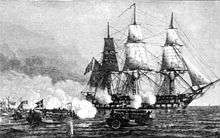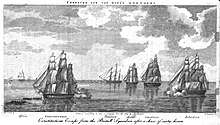HMS Africa (1781)
HMS Africa was a 64-gun third-rate ship of the line of the Royal Navy, launched by Barnard at Deptford on 11 April 1781.[1]
.jpg) HMS Africa | |
| History | |
|---|---|
| Name: | HMS Africa |
| Ordered: | 11 February 1778 |
| Builder: | Barnard, Deptford |
| Laid down: | 2 March 1778 |
| Launched: | 11 April 1781 |
| Fate: | Broken up, May 1814 |
| Notes: |
|
| General characteristics [1] | |
| Class and type: | Inflexible-class ship of the line |
| Tons burthen: | 1,38583⁄94 (bm) |
| Length: | 159 ft (48 m) (gundeck) |
| Beam: | 44 ft 4 in (13.51 m) |
| Depth of hold: | 18 ft 10 in (5.74 m) |
| Propulsion: | Sails |
| Sail plan: | Full rigged ship |
| Armament: |
|

American War of Independence
During the American War of Independence, she was sent out to India in early 1782 as part of a squadron of five ships under Commodore Sir Richard Bickerton, arriving too late for the battles of that year. Africa never made it to America and remaining in India, taking part in the last battle of that war, at Cuddalore in 1783. She returned to England once news of the peace treaty arrived.
Napoleonic Wars
Africa was present at the Battle of Trafalgar in 1805 under the command of Captain Henry Digby. Having been separated from the main British fleet before the battle, Africa arrived from a different direction without knowing the battle plan that Admiral Horatio Nelson had devised. As the rest of the fleet engaged the combined Franco-Spanish fleet in a pell-mell battle, Digby sailed Africa down the line of enemy ships in a parallel fashion, exchanging broadsides.
Gunboat War
During the Gunboat War, Africa was under the command of Captain John Barrett.[2] On 15 October 1808, Africa was escorting a convoy of 137 merchant ships in the Baltic, with the assistance of the bomb vessel HMS Thunder and two gun-brigs. They left Karlskrona that day and on 20 October they anchored in the Øresund off Malmö. At noon a flotilla of Danish gunboats was seen moving towards the convoy and Africa sailed to intercept them.[3] The flotilla consisted of 25 gunboats and seven armed launches, mounting some 70 heavy cannons and with an overall total of some 1600 men.[3] It was under the command of Commodore Johan Cornelius Krieger.[4]
At 1:30 the wind died and Africa was immobilized. By 2:50pm the gunboats had stationed themselves off Africa's quarters, where few of her guns could fire, and opened fire. The battle continued until 6:45pm when with night closing in all firing ceased. Had daylight lasted another hour the Danes might have captured Africa, however nightfall meant both forces left the battlefield without victory for either side.[3] As it was, she had lost 9 men killed and 51 wounded, including Barrett. She was so badly battered that she had to return to Karlskrona for repairs.[3] The convoy, however, managed to reach Britain.
In 1810 George Frederick Ryves commanded Africa, in the Baltic, from which he brought home a large convoy, notwithstanding the severity of the weather and the violence of the gales.
John Houlton Marshall promoted to commander on the ship at a ceremony held on 21 October 1810 to commemorate the Battle of Trafalgar.
War of 1812

Under the command of Captain John Bastard, Africa was part of Sir Philip Broke's squadron that pursued, but ultimately failed to catch USS Constitution early in the War of 1812.[5]
Fate
Africa was broken up in May 1814 at Portsmouth.[1]
Notes
- Lavery, Ships of the Line, vol. 1, p. 181.
- AFRICA in Not - der dänische Kanonenbootkrieg 1808 (German)
- Allen (1852), Vol. 2, pp.251-2.
- Royal Navy.org Archived 22 July 2011 at the Wayback Machine
- James, William (2002) [1827]. The Naval History of Great Britain, Volume VI, 1811–1827. London: Conway Maritime Press. pp. 92–93. ISBN 0-85177-910-7.
References
- Allen, Joseph (1852) Battles of the British navy. (H.G. Bohn).
- Lavery, Brian (2003) The Ship of the Line - Volume 1: The development of the battlefleet 1650-1850. Conway Maritime Press. ISBN 0-85177-252-8.
External links
